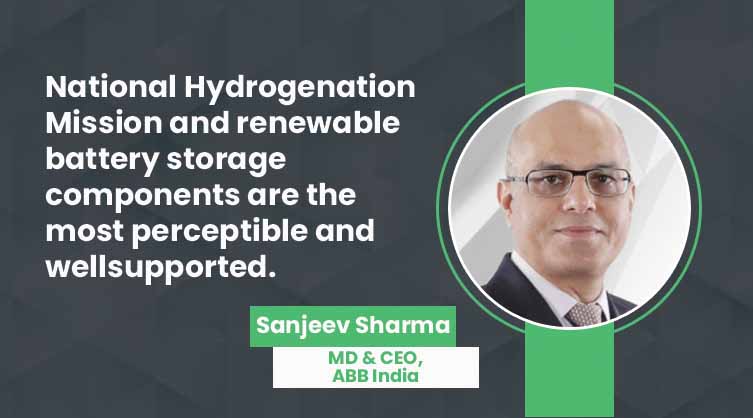Global energy ambitions are driving us toward energy transition
By EPR Magazine Editorial May 27, 2022 2:44 pm IST
By EPR Magazine Editorial May 27, 2022 2:44 pm IST

Excerpts from the recorded keynote speech at Distribuelec 2022 by Sanjeev Sharma, MD & CEO, ABB India.
Talking about the energy efficiency trends in the electrification business at ABB, during his keynote address at the Distribuelec 2022, Sanjeev Sharma, MD & CEO, ABB India, views that digitalisation of gas distribution networks is a huge trend across the country.
ABB has been active in India for the last 100 years and has been manufacturing here for 70 years. Our presence is spread in five major cities, including Bangalore, Nashik, and Faridabad, with R&D and Global Business Service Centre in Bangalore. ABB operates on crucial business models, with each country having 23 market divisions, specialising in energy efficiency, also known as motion business; Process Automation, Industrial automation, and robotics, among the others.
Electrification and energy efficiency business at ABB
ABB has been in India for the past 100 years, with approximately 70 years spent manufacturing. We have about five key facilities, including R&D centres in Bangalore and the “Global Business Services Center.” In this industry, we have a strong market, with approximately 15 of the 93 market sectors to which we are exposed falling by 10 percent or more. Around seven or eight market segments are expanding at greater than 15 percent. And eight market divisions are rising at a rate of approximately 7-8 percent, with only one market division, power, showing a negative trend. However, demand is weakening in the majority of market segments. But still, they are mighty, and we can see this in our order books, as well as a strong formation of inquisitive banks as we engage with the market.
Energy infrastructure at ABB
So as a player, we can participate in the length and breadth of the country’s infrastructure projects. 26 out of 28 states, including smart cities, utilise ABB power distribution technologies. The motors we supply with energy efficiency motors have over 20 terawatt-hours of energy saved. So just imagine all the industry is supposed to be hired as an agency motors, all the replacements and without the new board consumption future will be contributing to much more security or saving the same thing goes with the macros and many infrastructure projects we are very proud to have participated.
ABB’s initiatives and achievements toward sustainability
When it comes to sustainability, I think as an industry, and as a corporation, we should first act and then talk about it. So, they hear what we already have as ABB Global 2030 target based on SDGs. We at ABB follow our in-house standards and prescribed national standards with approximately ten specific points for ESG. So, one has to focus on green infrastructure, green manufacturing, and green products. And they are already on the green infrastructure side. We have already converted all our locations.
Digital transformation and energy transition trends
For excellent reasons, global and national ambitions are driving the world toward an energy transition. One is India’s 500 GW non-fossil power target for 2026. So, if our next generation is in charge of running our businesses, they should first focus on these other macro-factors before expanding or participating in them.
Second, we intend to reduce our carbon intensity by 40 percent. An entire industry is dedicated to assisting people who want to achieve 50 percent company penetration by 2030. It is yet another massive industrial expansion and residential and commercial structures. This will require the country to invest between $10 and $15 trillion until 2027. Of course, the “National Hydrogenation Mission” and renewable battery storage components are the most perceptible and well-supported.
Achieving net-zero carbon emission in the power sector
In the net-zero scenario, achieving CO2 emissions by every sector implies that the power sector will be the primary and most significant contributor. The availability of low-emission fuel greatly aids reductions. I believe there is a growth opportunity that all industry leaders can spend if they all participate in these segments. We can see a shift from what we had in 2010, when oil or low carbon intensity-based power generation was 90 percent, to nearly 50 percent, by 2050.
We use cookies to personalize your experience. By continuing to visit this website you agree to our Terms & Conditions, Privacy Policy and Cookie Policy.